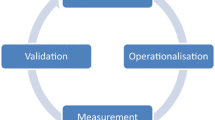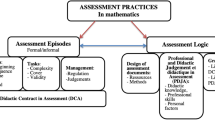Abstract
This paper takes a historical perspective to review the development of assessment practice, in China, which is outlined with a focus on the purpose and function of different assessment practices. Specifically, civil examination in imperial China served the purpose of selection and had the functions of directing and propelling educational activities. Various examinations used in modern China have kept the similar purpose as civil examination but changed in other ways. Several other assessment methods developed in modern China have shown more promise for improving mathematics education than examinations, but further efforts are needed for their development. The value of reviewing Chinese assessment practice historically is then addressed in an international context. The accomplishment of this review itself suggests that focusing on the purpose and function of an assessment is a feasible approach for reviewing assessment practice in other educational systems.
Kurzreferat
Der Beitrag gibt einen Überblick über die Entwicklung der Leistungmessung in China unter historischen Gesichtspunkten, wobei der Schwerpunkt auf Zweck und Funktion verschiedener Bewertungspraktiken liegt. Insbesondere dienten staatliche Prüfungen im imperialistischen China Auslese und sie hatten die Funktion, Aktivitäten im Bildungswesen zu lenken und zu fördern. Verschiedene Prüfungen im modernen China haben einen ähnlichen Zweck wie die staatlichen Prüfungen behalten, haben sich aber auf andere Weise geändert. Einige andere Bewertungsmethoden des modernen China scheinen im Hinblick auf eine Verbesserung des Mathematikunterrichts erfolgversprechender zu sein als Prüfungen; für ihre weitere Entwicklung besteht jedoch noch Forschungsbedarf. Diese historische Betrachtung der Leistungsmessung in China wird dann in einen internationalen Kontext gestellt. Die Ausführung der vorliegenden Arbeit selbst zeigt, dass die Hinterfragung von Zweck und Funktion einer Bewertung ein geeigneter Weg ist zur kritischen Betrachtung von Bewertungspraktiken in anderen Bildungssystemen.
Similar content being viewed by others
References
Borthwick, S. (1983: Education and social change in China: The beginnings of the modern era.— Stanford, CA: Hoover Institution Press, Stanford University
Cheng, Z.; Lu, S. (1993: The practice and study of evaluating mathematics teaching in China.— In: M. Niss (Ed.), Cases of assessment in mathematics education: An ICMI study, Dordrecht: Kluwer Academic Publishers, p. 193–201
Du, R.-Q. (1992: Chinese higher education.— New York: St. Martin's Press
Examination Center of Chinese State Educational Commission (1991): Directions for mathematics test of National University Entrance Examination (in Chinese).— Beijing: People's Educational Press
Franke, W. (1960): The reform and abolition of the traditional Chinese examination system.— Cambridge, MA: Harvard University Press
Galt, H. S. (1951): A history of Chinese educational institutions, Vol. I.— Hertford: Stephen Austin and Sons, Ltd.
Glaser, R.; Silver, E. (1994): Assessment, testing, and instruction: Retrospect and prospect.— In: L. Darling-Hammond (Ed.), Review of research in education 20. Washington, DC: American Educational Research Association, p. 393–419
Gu, M. (1984): The development and reform of higher education in China:— In: Comparative Education 20 (No. 1), p. 141–148
Hu, C. T. (1984): The historical background: Examinations and controls in pre-modern China.— In: Comparative Education 20 (No. 1), p. 7–26
Jami, C. (1994): Learning mathematical sciences during the Early and Mid-Ch'ing.— In: B. A. Elman; A. Woodside (Eds.), Education and society in late imperial China, 1600–1900. Berkeley and Los Angeles, CA: University of California Press, p. 223–256
Lee, P.-Y.; Zhang, D. (1991): Examination cultural and mathematics teching.— In: S. Yan; S. Zhong; E. Ding; C. Cao; R. Sun; Y. Li (Eds.), Proceedings of the ICMI-China Regional Conference on Mathematical Education, Beijing: Beijing Normal University
Lee, T. H. C. (1985): Government education and examinations in Sung China.— Hong Kong: The Chinese University Press
Li, Y.; Du, S. (1987): Chinese mathematics: A concise history.— Oxford: Clarendon press
Martzloff, J. C. (1994): Chinese mathematics.— I. Grattan-Guinness (Ed.), Companion encyclopedia to the history and philosophy of the mathematical science Vol. 1 London: Routledge, p. 93–103
Mathematical Science Education Board, National Research Council (1995): Measuring what counts.— Washington, DC: Mathematical Science Education Board
National Council of Teachers of Mathematics (1995): Assessment standards for school mathematics.— Reston, VA: National Council of Teachers of Mathematics
Niss, M. (Ed.) (1993): Cases of assessment in mathematics education: An ICMI study.— Dordrecht: Kluwer Academic Publishers
Silver, E. A.; Kenney, P. A. (1995): Sources of assessment information for instructional guidance in mathematics.— In: T. A. Romberg (Ed.), Reform in school mathematics and authentic assessment, New York: SUNY, p. 38–86
Swetz, F. (1972): The amazing “Chiu Chang Suan Shu”— In: The Mathematics Teacher 65 (No. 5), p. 423–430
Tian, W. (1990): Nationwide investigation and analysis of mathematical teaching and learning at middle schools (in Chinese). — Shanghai: East-China Normal University Press
Unger, J. (1984): Severing the links between school performance and careers: The experience of China's urban schools, 1968–1976. — In: Comparative Education 20 (No. 1), p. 93–102
Wang, L.Q. (1992): Chinese advancements in mathematics education. — In: Educational Studies in Mathematics Vol. 23, p. 287–298
Weber, M. (1968): The Religion of China.— New York, NY: Free Press
Wei, C.; Zhang, H. (1993): Educational assessment in mathematics teaching: Applied research in China.— In: M. Niss (Ed.), Cases of assessment in mathematics education: An ICMI study. Dordrecht: Kluwer Academic Publishers, p. 183–191
Zhang, D. (1992): Some puzzling questions arising from mathematics education in China.— In: I. Wirszup; R. Streit (Eds.), Developments in school mathematics education around the world, Vol. 3, Proceedings of the UCSMP International Conference on Mathematics Education, Reston, VA: National Council of Teachers of Mathematics
Zhu, Z.Q.; Monroe, E. E. (1991): Mathematics education in China today: Four problem areas.— In: Educational Studies in Mathematics Vol. 22, p. 205–208
Author information
Authors and Affiliations
Additional information
I am grateful to Edward A. Silver for reading earlier versions of the paper. His comments helped me see and organize the points I was trying to make. I also want to thank Elizabeth George for her helpful comments and Rita A. Hibschweiler for her editorial suggestions.




